Director Sam Fell had a lot to live up to when taking on the sequel to Aardman Animations’ beloved Chicken Run. Fell and the key creatives talk about crafting a rescue-mission movie with flavours of James Bond.
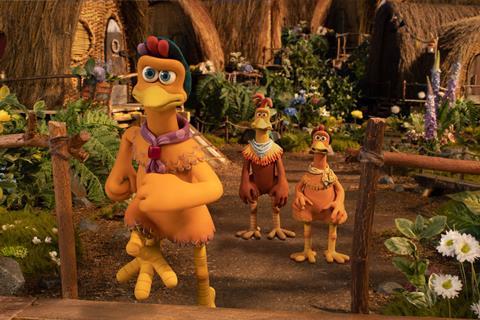
The release of Chicken Run in June 2000 was a watershed moment for Bristol-based claymation studio Aardman Animations. Previously, it was best known for British children’s TV character Morph, for memorably animating Peter Gabriel’s ‘Sledgehammer’ music video, and for its beloved (and Oscar-winning) Wallace and Gromit shorts. But not only was Nick Park and Peter Lord’s Great Escape-riffing tale of hens breaking out of a poultry farm Aardman’s first-ever feature film — backed and distributed by DreamWorks Animation — it also broke all records to become the highest-grossing stop-motion movie of all time. Its worldwide haul of $225m still has not been beaten.
“As word of mouth spread, it just stayed in theatres and slowly ramped its way past $100m [in North America],” recalls screenwriter Karey Kirkpatrick in a tone that suggests he still cannot quite believe it. “It remains to this day one of the single-most satisfying creative experiences of my life.” One that he and co-writer John O’Farrell were happy to repeat — though they would have to wait for more than two decades.
Aardman did not rush to make a sequel, which might say something about how the studio’s chosen art form is, frankly, impossible to rush. (In stop-motion, it typically takes around two working days to animate one second.) But it says more about how absolutely certain they needed to feel that they could beat, or at least match creatively, Chicken Run — which earned Bafta nominations in 2001 for outstanding British film and visual effects. To do so, they needed to figure out the best way to bring back quick-witted escape planner Ginger, cocky American circus rooster Rocky and their idiosyncratic crew.
“I know they’d been brainstorming over the years, trying to figure out the next one,” says Sam Fell, director of the eventual sequel Chicken Run: Dawn Of The Nugget, which would find a home at Netflix after the success of Aardman/Netflix short Robin Robin. A former mentee of studio co-founder Lord, Fell was directing commercials at Aardman when the first film was released, then went on to make the studio’s CGI debut Flushed Away (2006), before directing The Tale Of Despereaux (2008) for Universal Pictures and ParaNorman (2012) for Laika. “Obviously, the bar was so high because the first Chicken Run was so great,” he continues. “I loved the way it walked the line between dark and light, drama and comedy. The film had such range. But I think it was Karey who figured out the trick that unlocked the sequel.”
If that is true, Kirkpatrick is not hogging the credit. After being approached in 2018, while in the midst of writing the Mrs Doubtfire stage musical with brother Wayne Kirkpatrick and O’Farrell, he recalls an early discussion with Lord and Park. “We all landed on the exact same basic premise, which was one phrase — ‘This time they’re breaking in.’ We all said, ‘Yes! That’s what the story should be.’ If the other one was an escape film, this one would be a heist movie.”
Rescue mission
The writing process, however, did not progress quite so smoothly. On deciding the most precious thing Ginger and Rocky would need to heist was the offspring they had hatched together, the writers brought back a character that had been cut from the first film: “A little boy chicken,” Kirkpatrick says, named Nobby. He and O’Farrell — a UK writer whose screenwriting credits include satirical shows Spitting Image and Have I Got News For You — then crafted a father-son narrative, focusing on Rocky pining for his glory days and feeling inadequate as a father.
“We had a whole subplot of him doing cockfighting,” reveals O’Farrell. “He was in a boxing ring, with really scary boxing chickens beating seven shades out of him.” But after presenting an animatic of their outline to Aardman, Kirkpatrick says, “every woman that saw it said, ‘What are you doing? The first movie was a feminist anthem and you’ve turned it around and made it a father-son story!’ We said, ‘You’re right. What were we thinking?’”
After bringing on board Rachel Tunnard (known for her own Adult Life Skills and Peter Cattaneo’s Military Wives) to co-write, they recalibrated to a mother-daughter story. Now the settled-down Ginger had to contend with young Molly (voiced by The Last Of Us star Bella Ramsey) — a “chick off the old block”, as Fell puts it, who seeks adventure beyond the borders of the island haven Ginger found for her flock since escaping Mrs Tweedy’s pie-making operation in the first film.
Molly’s wanderings land her in trouble when she is trapped in a high-tech factory farm run by none other than Ginger’s old nemesis, who is wreaking her revenge on all chicken-kind via the invention of the chicken nugget. With the film updating from the wartime vibe of Chicken Run to a 1960s aesthetic, the farm’s exterior deliberately recalls the slick, brutalist production design of Sean Connery-era James Bond.

“I got excited about exaggerating this factory to the scale of a Bond villain’s lair,” says Fell. Meanwhile, the original conception of its interior as a grim, cage-stacked space struck the director as rather too harsh and bleak. “I wanted to make sure it was fun and colourful to be in there for 60 minutes,” he says. This led to the conception of Fun-Land, an ersatz chicken-themed amusement park designed to distract and entertain its mind-numbed inhabitants, keeping their stress levels down to make their meat more tender and tasty. As Kirkpatrick puts it, they went from “Alcatraz” to “Center Parcs”.
All of which had a significant impact on the scale of the production — not least because, unlike the first film, which rarely mixed up the chicken and human worlds and could largely be presented on a hen-sized scale, this one would see the birds venture into a vast human-scale environment.
“It was quite a while before we said, ‘Oh blimey. This is going to be a huge challenge for the studio to tell a story on this scale, on this giant canvas,’” says Fell. “Because of Covid, a lot of early pre-production happened on Zoom. It wasn’t until we got back into the studio and the first sets started arriving on the studio floor that everyone was like, ‘Sam, this is a bit big…’”
Quite simply, there was not enough space at Aardman’s studio in Bristol’s Aztec West industrial park to build the required sets. The solution was to devise a hybrid approach, complementing Aardman’s traditional, handcrafted stop-frame puppetry with substantial digital elements, including CG scenery that could be arranged via virtual production techniques and several hundred “digi-double” chickens.
“We got to this point where we decided, ‘If Sam wants this scale, we are going to have to throw everything at it,’” says production designer Darren Dubicki, an Aardman veteran who worked on the first film. “And luckily we now have our own, experienced in-house VFX team who we knew could create this much bigger world that was required, but at the same time be aware of the sensitivities and sensibilities of keeping it feeling like a big model-set world. We wanted to make sure that was retained throughout.”
Refreshing the cast
One thing that was not retained, however, was the film’s original cast. Or at least, many of its members — including its two leads. Julia Sawalha and Mel Gibson have notably been replaced in the roles of Ginger and Rocky by Thandiwe Newton and Zachary Levi. Yet at the same time, Jane Horrocks, Imelda Staunton and Miranda Richardson have all returned as, respectively, the clueless Babs, the stolid Bunty and the evil Mrs Tweedy.
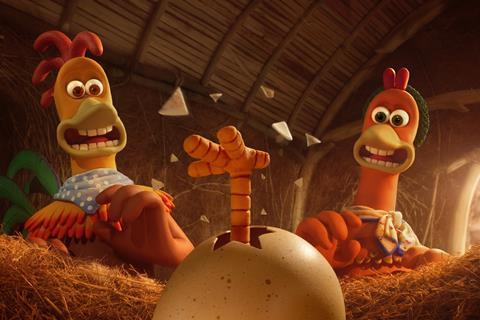
“It’s been a long time since the first movie — over a quarter of a century since they made those casting decisions,” explains Fell. “And to me, this film is almost more of a reboot than a straightforward sequel. So I thought it would be reasonable to open the door and consider everybody for every role, especially as some of the characters have evolved.
“It’s the next chapter for Ginger’s story,” Fell continues. “There’s more complexity now in her tale — of the mother who is at once very strong and very vulnerable. I got that sense of power and vulnerability from Thandiwe in [HBO’s] Westworld, so I felt drawn to that choice. Similarly, Rocky is now more of a lighter comic role, and he doesn’t have to carry quite as much. And Zach has amazing comic timing and a tremendous warmth in his voice. But other characters have not changed so much. I mean, Babs is still Babs and Jane is still Jane, you know?”
But what about Richardson, who has returned to a role that has evolved into a beehive-wearing Bond villain? “Miranda has a unique handle on drama and comedy,” Fell says. “She can scare the pants off you and make you laugh in the same moment. Some of [the casting decisions] were pretty subjective, but in the end I’m really happy with the performances. I would say the casting of the first film was fantastic, and the casting of this film is also fantastic.”
Dawn Of The Nugget received its world premiere at the BFI London Film Festival last October, achieved a limited theatrical release in the UK and US in early December, then landed on Netflix’s streaming platform on December 15 — with a view to generating tens, or hundreds, of millions of views in homes over the festive period.
As for Fell’s future plans, he jokes, “Have a bit of a lie-down.” There are things he wants to do once rested but, he points out, “It’s tricky because they all take such a long time.” He has, after all, spent more than five years working on this 23-years-coming sequel. Which begs the question, could there be a third Chicken Run adventure?
“I do think there’s more to be done with Chicken Run and those characters,” he says. “I’m not sure if it’s going to be me [directing it], or what that story is, and there’s no real solid plan to do that. But it feels like a trilogy.”
Would Kirkpatrick and O’Farrell be prepared to write episode three in time for, say, 2046? “I think we’re going to be a bit late with that script. It might be 2047,” deadpans O’Farrell. “I don’t know if there’s a Chicken Run 3 in us. Or in Aardman. It would have to be as good as the first two.”
Whatever technological advances have happened by then, Fell is certain the series should hold onto its clay-moulded heart. “There’s something about the handmade that has a warmth to it,” he says. “It’s tactile. It’s direct. The technology of stop-motion is over 100 years old, but it’s still beautiful and brilliant and can still touch you in the deepest way. Therefore, we shouldn’t throw it away.”
Production designer Darren Dubicki on Dawn Of The Nugget’s expansive environments
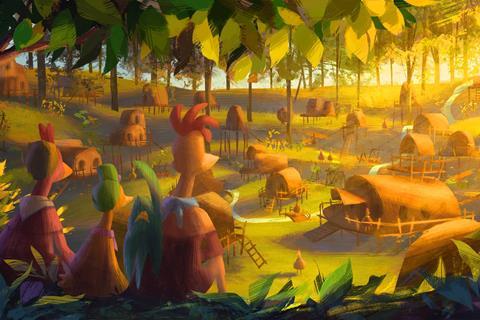
The island
This leafy, gadget-filled mini-utopia was the production’s biggest physical set. “It’s full of organic material — trees and huts and flowers,” says production designer Darren Dubicki. “It took months, maybe a year to complete in its entirety.” Unfortunately, at one point during production it was threatened by a leaky roof at Aztec West. “Maybe a few drops landed on our miniature island but it was caught just in time. Production were brilliant at relocating the units and moving things away from the leak.”
The factory farm
“It was a dream job, to step into Ken Adam territory and create a Bond villain’s lair,” says Dubicki, referring to the legendary production designer who worked on seven James Bond movies, from Dr. No to Moonraker. “And take it to the max, because Sam wanted everything exaggerated as much as possible.” For example, while Dubicki was designing the spiral staircase on which Mrs Tweedy would make her entrance, Fell requested that he add more steps. “He wanted to over-egg the pudding when it came to her reveal.”
Fun-Land
“This area is Butlin’s for chickens,” says Dubicki, referencing the UK holiday resorts. The pastel-shaded amusement park provides a disturbingly cheery front for Tweedy’s nugget-making slaughterhouse. Being too expansive to build entirely as physical sets, “we created this virtual world, which allowed Sam to be on set within the foreground part — with a couple of greens and key props, maybe some chickens playing volleyball — and then beyond that there was the virtual version of Fun‑Land. It was effectively a digital model shop, where Sam could say, ‘Let’s move these elements around and try this camera move and see what happens, and make sure this virtual world is aligning with our physical world.’”

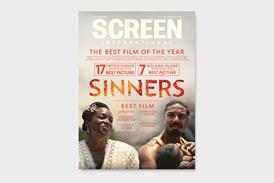


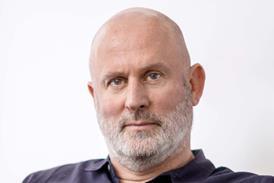
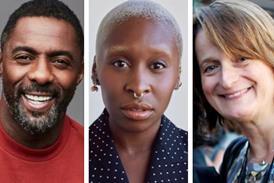






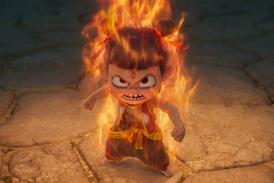
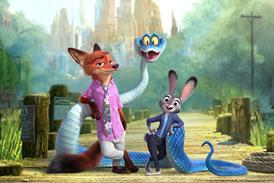
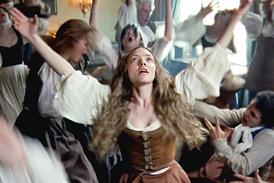

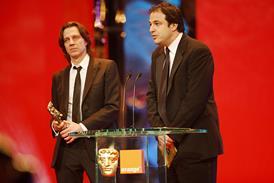






No comments yet